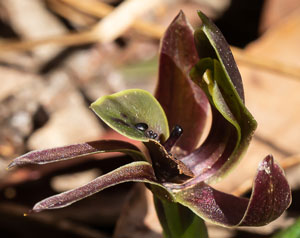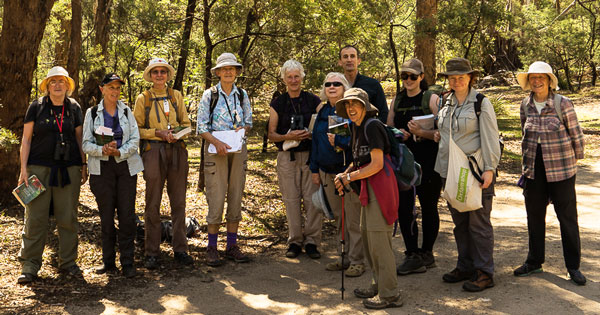Yearly programs (with reports from outings where available):
2026 2025 2024 2023 2022 2021 2020 2019 2018 2017 2016 2015
Beautiful fine and cool January day. The array of flora and form seemed to indicate that this area is a boundary between upper and lower mountains. Acacia linifolia was in flower. Grevillea laurifolia specimens growing here had the larger upright leaves of the lower mountains area. Among the many lovely plants seen in flower were Cryptostylis erecta, Dipodium punctatum, Scaevola ramosissima, both Dampiera purpurea and D. stricta, masses of Petrophile pulchella, some to about 4m tall. There were several species which posed problems but we thoroughly enjoyed the challenge.
The park is in good condition although some weed infestation seen at the edge and near the picnic area. There has not been any recent bush fires. A wide variety of plant communities, very little in flower, Epacris pulchella was in flower. Cryptostylis erecta sighted, abundant Persoonia mollis, well established Angophora costata, Eucalyptus piperita, Acacia elata formed the lovely forest. A small population of the endangered Pultenaea glabra which were along the board walk/stream have been removed due to clearing in the area. There are some random healthy plants further along the track but in a vulnerable position due to any possible future clearing or widening of the track.
Our first successful bus trip for the year had 13 active members of plant group and the nursery present. We looked at two plant communities beside the Wolgan River.
The first stop was at the Old Coach Road ford crossing of the river where the Capertee - Wolgan Riparian Rough-barked Apple - River Oak Open Forest can be seen. Angophora floribunda, Casuarina cunninghamiana and Pomaderris eriocephala were present.
Next stop was at Newnes old museum, where we crossed the river and identified plants in the Wolgan Riparian Scrub Complex. Vegetation was sparse on the north-west slope where we found Eucalyptus melliodora, E. blakelyi and E. viminalis which grows abundantly on the alluvial flats of the valley, and noted the low presence of Proteaceae.
Despite the intrusion of Radiata pines the plateau exhibits an abundance of species similar to other upper mountain communities e.g along Narrow Neck road and Cahills Lookout. Eucalyptus oreades and E. sieberi as well as other eucalypts are slowly replacing the Radiata. Leptospermums, including L. trinervium and L. polyanthum were abundant with L. squarrosum in flower. Bossiaea heterophylla was also flowering. The highlights of the walk however, were the discovery of flowering Drosera spathulata, which populated a small area close to the remains of the rapidly receding water at the dam west of the main fire trail, and the sighting of several specimens of Arrhenechthites mixtus, at the end of flowering but with distinctive purple underside of leaves.
The walk commenced at the end of Helvetia Ave, Blackheath, and followed the walking track to Fort Rock, with botanising focused on the heath community there and down the track to the escarpment edge, overlooking the Kanimbla Valley. Bird watching was also a feature of this walk, with nectar seekers active and a spectacular low fly over by a Wedge-tailed Eagle. On this fine day lunch was enjoyed amongst the heath plants.
We were very lucky with the weather as a gloomy morning turned into a reasonable day without rain while we were at Jackson Park. The area has been dry and there were not the numbers of orchids flowering that were present last year. The highlights for me were Persoonia pinifolia but even more so was a lovely Red Triangle Slug Triboniophorus Athoracophoridae which was a bonus. We saw several Pterostylis longifolia and one of my favourites Pterostylis grandiflora and a lovely flowering group of Acianthus fornicatus var. fornicatus. I think the orchid that won the day was Caladenia picta. We added several plants to the Jackson Park plant list.
Caladenia picta, Cryptostylis erecta, Cryptostylis subulata, Eucalyptus globoidea, Eucalyptus notabilis, Leucopogon setiger, Monotoca scoparia, Persoonia linearis.
The walk was from the Tunnel View Car Park in Glenbrook National Park. Although there were very few flowers out, there was a good diversity of plants all along the 200 metre track and in nearby bush land. Highlights included Dodonaea pinnata and an Acacia juncifolia growing on exposed rock at the edge of the Lookout. We had some helpful lessons on identifying some of the Myrtaceae species by capsule and bark appearance.
Ten plant group members and our driver had a most informative and stimulating day at the Botanic Gardens. A Senior Horticulturalist, on the bus trip around the gardens, pointed out differing vegetation and soils, as well as showing us the regrowth Cumberland Plains Vegetation Community in the Sydney Bioregion.
After lunch in the central gardens, we were taken on tour by the manager of the Plant Bank where we learned of the important scientific work staff do in collecting, identifying and preserving seeds in NSW & around Australia.
A lively discussion ensued with both of our guides and we came home understanding what an important role Mt Annan plays in Australian flora conservation.
A two kilometre return walk along fire trails through Crown land to the north of Warrimoo. We were dismayed by the lack of flowers, even buds, and the dryness of the bush. Many plants looked stressed. Young turpentines were drooping and we wondered if the appressed leaves of some of the Bossiaeas and Dillwynias were also a drought response. The only species showing some flowering were Acacia suaveolens, Boronia ledifolia, Grevillea phylicoides and Hardenbergia violacea. So our time was spent honing our ID skills using solely vegetative characteristics, especially on stringybarks, Persoonia and sedges. Quite a challenging day.
Early spring in the Lower Mountains was a challenge for native plant enthusiasts as many months of drought meant that there were few flowers about and the bush was looking quite water-stressed. Nevertheless the group assembled at Adeline Park in the Linden Creek catchment and spent a productive morning investigating the woodland and heath. This is a special place dominated by sandstone and the Faulconbridge Mallee Ash Eucalyptus burgessiana the type specimen of which, we learnt, was in 1953 from near our study site by Blue Mountains eucalyptologist, the Rev. Colin Burgess and L.A.S. Johnson of the Royal Botanic Gardens. Instead of walking far the group set up a table and chairs and practised keying a range of plants using Flora of the Sydney Region (Pellow et al). Several group members are sedge enthusiasts and this location provided some excellent examples of plants that included Lepyrodia scariosa, Ptilothrix deusta and Schoenus imberbis that everyone identified using Van Klaphake’s excellent Key to Sedges and Rushes of the area.
The best time to see a swamp Bushcare site is during heavy rain such as was happening during this outing. We saw the turbulence as water flowed around rocks and other strategically placed obstructions. The more kinetic energy of the water that produces noise and is dissipated as heat energy, the less erosion downstream.
The above is one of the many examples on the site where science has been applied to eradicate huge thickets of weeds and improve hydrology while minimising erosion and sedimentation.
The outing provided us insights about how a dedicated group of people have transformed an eyesore and weed "nursery" into a beautiful buffer between the urban environment and the National Park.
The weather was perfect and the soaking rains since my visit two months earlier had rejuvenated the vegetation and the wildlife. Our first stop was in the magnificent patch of tall eucalypt forest, including Eucalyptus fastigata and E. cypellocarpa, at the north-eastern end of Hassans Walls Road. The light green, bell-shaped flowers of Billardiera mutabilis were in full bloom.
We spent most of the outing near the Second Lookout where there was prolific flowering of plants in the heath and in the wide transitional zone between it and woodland. The white flowers of Hakea dactyloides were striking. On the micro scale, we saw several Pseudanthus divaricatissimus plants. The field guide Native Plants: Hassans Walls Reserve Lithgow is an invaluable resource for learning about the biota of the reserve.
 Chiloglottis chlorantha (Robin Murray)
Chiloglottis chlorantha (Robin Murray)
The weather was very hot for our last morning of the year but the bush on the fringes of Wilson Park was looking quite lush after the rain of recent weeks. Appropriately we chose to investigate ferns and after a short introduction to fern morphology and reproductive structures we meandered along the stream and the fringing swamps where we keyed a range of species. We were able to look at the differences between the large fronded species of Todea barbara, Cyathea australis and Dicksonia antarctica (planted). The two common species of Gleichenia, G. dicarpa and G. microphylla were identified and we noted that that the latter is often called the former, and we keyed Blechnum minus that is often confused with B. cartilagineum. In addition to ferns there was also a collection of interesting flowering natives that are often not seen including Lobelia anceps, Scaevola albida and Viola silicestris.
As the morning temperature climbed we sought shelter beneath a large spreading tree in the park and enjoyed an end-of-year shared lunch. This was a special occasion as it saw the retirement of our extremely capable co-ordinator Susan Jalaluddin who will be very much missed in this role. Don Cameron has provided capable back-up support for the group "leader" over many years and he was thanked for his important role. The responsibility for the group was then handed on to Helen Yoxall who we know will capably supply us with new plant challenges and discoveries in 2019.
We acknowledge the traditional custodians of this land
the Darug and Gundungurra people
and pay respect to their Elders past and present.

 Plant Study Group in the Wolgan Valley (Meredith Brownhill)
Plant Study Group in the Wolgan Valley (Meredith Brownhill)